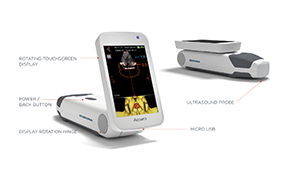 When they were students in the biomedical engineering department at the University of Virginia, Will Mauldin and Kevin Owen found a problem that needed solving – anesthesiologists often fail to successfully place an epidural on their first try.
When they were students in the biomedical engineering department at the University of Virginia, Will Mauldin and Kevin Owen found a problem that needed solving – anesthesiologists often fail to successfully place an epidural on their first try.
It’s a problem that costs the medical system more than $1.5 billion each year, according to Rivanna Medical.
“The failure rates are between 30 – 80% depending on the type of patient and the user’s skill. So, that sounded very high,” Mauldin told Drug Delivery Business News. “Meanwhile, ultrasound had basically taken over in the anesthesia field for all kinds of other procedures, such as vascular access and peripheral nerve blocks, but for some reason it’s still not widely used for neuraxial anesthesia.”
So the pair founded Rivanna with the intention to create a device that could help boost the efficacy of neuraxial anesthesia, focusing first in the labor and delivery setting.
Mauldin said they began by deciphering why ultrasound was not being used as an image-guidance technology for anesthesiologists placing epidurals. Speaking with people in the field, the team found that there were two primary obstacles to adoption.
“It’s a combination of just not being practical to get the equipment where it needs to be at the right time and also, the learning curve’s too steep,” Mauldin explained. “A lot of providers aren’t willing to undergo the necessary steps to try and become proficient with it.”
To address these problems, Rivanna created a hand-held device the size of a smartphone that uses ultrasound to guide anesthesiologists with epidural depth and location.

In real time, the Accuro device displays an ultrasound image of the spine and an automated estimation of the spinal midline. The anesthesiologist’s first step is to get the spine’s midline centered in the image, Mauldin said. Then, the provider looks for the interlaminar space – the space between the spinous process bones. As they search for that space, the device will provide the depth to the epidural space, giving the anesthesiologist an estimate on how deep they’ll need to go with the needle to give an epidural.
On the bottom of Accuro’s screen, there is also a 3D model that combines the depth and location overlays derived from the 2D image.
In September, results from a clinical trial evaluating Accuro were published in Anesthesia & Anagesia. The study, which was conducted at Stanford University, found that Rivanna’s technology could predict epidural depth within an average of 0.61 cm.
The study also showed that Accuro identified the appropriate spinal interspace for needle insertion in more than 90% of patients and achieved 87% success in first-attempt epidural administration.
The 15-person company won 510(k) clearance for Accuro in June of 2015 and Mauldin said the company is continuously working to improve the device.
“I think any time you’re trying to change provider behavior, and really change standard of care, there’s a lot of resistance. A lot of it’s not resistance like, kind of forceful resistance, it’s just kind of inertia type resistance,” he added. “There are challenges for a company like us trying to basically create a market and change provider behavior.”
The company is focusing on its on-going clinical trials and R&D projects, but it’s also working to expand adoption.
“As we’ve gone through a couple capital equipment purchasing cycles, we have recognized that the best ways for providers to experience the technology is to actually trial it. Not just to have a rep come in and visit them for a day but to actually use it in their facility for at least a couple weeks. That program was started six months ago and that’s probably made the biggest difference for our adoption.”

